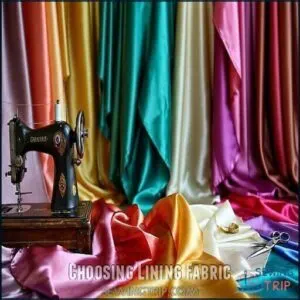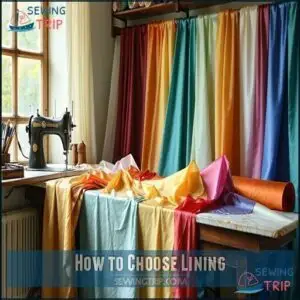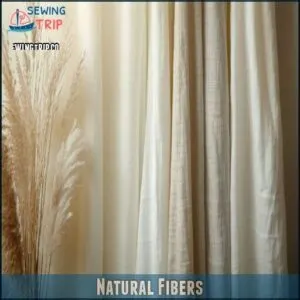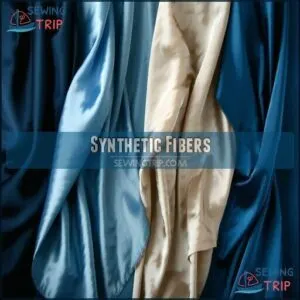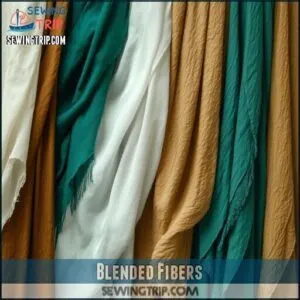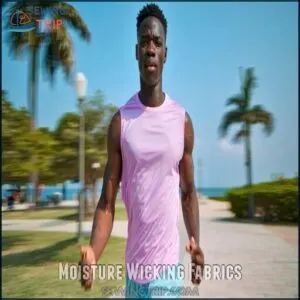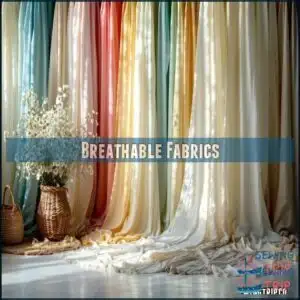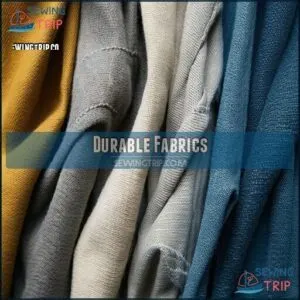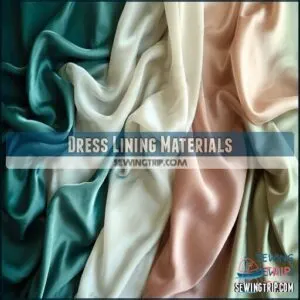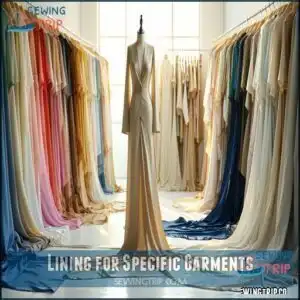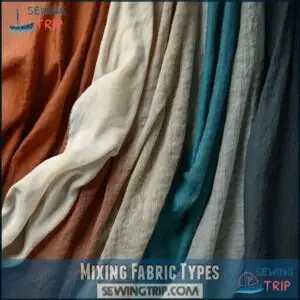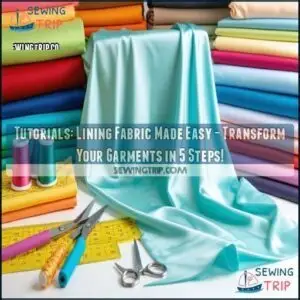This site is supported by our readers. We may earn a commission, at no cost to you, if you purchase through links.

First, match the color—neutral or complementary shades usually work best.
Then, think about the garment’s purpose.
For example, a summer dress needs breathable cotton or silk, while a winter coat calls for something durable and warm, like polyester blends.
Make sure the lining fabric is lighter and smoother than the outer fabric to avoid bulk and guarantee comfort.
It should slide against your skin or layers without snagging.
Always consider durability, care instructions, and style.
After all, the right lining can turn a good garment into a great one.
Table Of Contents
Key Takeaways
- Match the lining’s weight and compatibility with your outer fabric to ensure balance and durability.
- Pick breathable and comfortable materials like cotton or silk for summer garments, and warmer options like fleece or quilted polyester for winter wear.
- Coordinate your lining’s color to either complement or contrast the outer fabric, considering how the color might peek through seams.
- Choose a lining that’s smooth, durable, and easy to care for, aligning with the garment’s purpose and maintenance needs.
Choosing Lining Fabric
You’ll need to match your lining fabric to your outer material’s weight while considering both function and feel.
The right lining transforms your garment by adding structure, reducing friction, and creating a polished finish that makes your creation look truly professional.
A perfect lining adds elegance, structure, and a polished finish, transforming your garment into a truly professional masterpiece.
Colour of The Outer Fabric
When selecting lining fabric, your outer fabric’s color should guide your decision.
You’ll typically want to choose matching colors or complementary colors that enhance the overall look.
Dark linings work well with most garments, while contrasting shades can add unexpected flair.
For solid shell fabrics, consider printed linings to incorporate playful elements.
Remember that your lining color might peek through at seams, so choose wisely, and consider the overall visual impact.
Purpose of The Clothing
The purpose of the clothing shapes your lining choices.
Think about garment functionality, intended use, and occasion specificity. Seasonal needs and the desired aesthetic matter too.
For example:
- Summer wear: Opt for breathable cotton or silk.
- Evening gowns: Go for elegant silk satin or crepe.
- Winter coats: Choose warm quilted or fleece linings.
- Stretch garments: Use flexible jersey or tricot linings.
Compatibility With The Outer Fabric
When thinking about fabric compatibility, focus on weight harmony and drape synergy.
The lining should match the outer fabric’s fiber content and weave for smooth fabric pairing.
Care instructions matter too—don’t mix dry-clean-only linings with washable outer fabrics.
Solid shell fabrics work best with slippery linings to reduce friction, ensuring seamless wear and balanced fabric combinations, which is key to achieving seamless wear.
How to Choose Lining
Choosing the right lining can take your garment from good to great by improving its comfort, durability, and look.
The perfect lining elevates your garment, blending comfort, durability, and elegance for a polished, professional finish.
To make the best choice, think about the fabric’s weight, breathability, and how it works with the outer material, considering factors that improve its overall durability.
Geographic Content Challenges
Geographic content challenges affect choosing lining fabric due to regional preferences and local regulations.
You’ll need to navigate cultural sensitivity and language barriers while addressing global distribution concerns.
Follow these tips for clarity:
- Research lining fabric types popular locally.
- Check regional care standards.
- Respect fabric-related customs.
- Adapt fabric lining guides to diverse needs.
- Verify that products meet local regulations to ensure global distribution is successful and regional preferences are considered.
First-Mover Advantages
Being the first in fabric selection lets you set standards in choosing lining fabric.
It’s like claiming new territory—early choices create brand recognition and customer loyalty.
First-mover advantages give you market share and innovation leadership.
Explore lining fabric types based on properties like drape and breathability.
Mastering fabric selection guarantees you pick the best lining material for any garment, which can lead to brand recognition.
Platform Network Effects
Building on first-mover advantages, platform network effects highlight how the lining adoption rate grows as more choose specific lining fabric properties.
Achieving critical mass means indirect effects, like better fabric guides, kick in.
Positive feedback loops create a winner-take-all scenario where popular options dominate.
Smart fabric selection balances these effects, ensuring your lining fabric meets both style and functionality needs.
Lining Fabric Types
When choosing lining fabric, you’ve got three main options: natural, synthetic, and blended fibers.
Each type has unique properties that impact comfort, durability, and the overall feel of your garment.
Natural Fibers
Natural fibers bring comfort and functionality to lining fabric.
Silk offers smoothness and elegance, while cotton benefits include breathability and softness. Linen uses its crisp texture to keep garments cool, even in heat. Wool adds warmth for winter wear.
These fibers also vary in fabric weight and GSM, impacting their suitability for different garments.
Here’s why natural fibers shine:
- Breathable comfort
- Eco-friendly appeal
- Versatile drape
- Soft, natural feel
Synthetic Fibers
Synthetic fibers like polyester, acetate, and rayon are popular for their durability and cost-effectiveness.
Polyester properties include wrinkle resistance and easy maintenance, though it’s less breathable. Acetate uses shine in decorative garments, while rayon offers softness.
For knit linings, synthetic durability guarantees longevity. These manmade fibers provide smooth finishes, making garments easier to wear and maintain.
Many retailers offer various lining options for various lining needs.
Blended Fibers
Blended fibers combine the best of synthetic and natural fabrics, giving you performance blends that balance comfort and durability.
Hybrid fabrics like polyester blends or viscose-acetate lining offer cost effectiveness and versatility.
These fabric blends improve drape, reduce wrinkles, and enhance breathability.
You can find a variety of pre-made lining options online.
By choosing blending benefits, you’ll get linings that work harder while keeping your garments polished and functional.
Fabric Weight Considerations
Choosing the right fabric weight for your lining is vital to guarantee your garment drapes well and feels comfortable.
Lightweight, medium, and heavyweight fabrics each serve specific purposes, so matching them to your outer fabric is key to achieving balance and durability, ensuring the garment has the right balance.
Lightweight Fabrics
Lightweight fabrics are perfect for delicate garments and summer clothes, offering breathable options that feel airy and comfortable.
Silk Habotai and chiffon linings are popular for their soft texture and graceful drape.
When choosing lining fabric weight for summer dresses, focus on these:
- Silk Habotai: Lightweight and semi-sheer.
- Chiffon: Soft with a flowing drape.
- Cotton Voile: Breathable and crisp.
- Organza: Adds subtle structure.
Medium Weight Fabrics
Medium-weight fabrics strike a balance between structure and flexibility, making them versatile for various garments.
They offer moderate drape, opacity, and durability, suiting jackets or custom-made dresses. Pairing texture and weave density with outer fabric guarantees harmony.
Always check care complexity for maintenance ease. These fabrics provide enough breathability while maintaining lining fabric weight and opacity.
| Feature | Description | Example Uses |
|---|---|---|
| Drape Considerations | Moderate flexibility | Custom-made garments |
| Opacity Levels | Balanced coverage | Jackets, skirts |
| Texture Pairings | Smooth or matte finish | Blazers, dresses |
| Weave Density | Medium tightness | Everyday wear |
| Care Complexity | Easy to maintain | Workwear clothing |
Heavyweight Fabrics
Heavyweight fabrics like Canvas Linings, Denim Backing, and Wool Interlinings bring structure and warmth to garments.
Perfect for fall and winter coats, these linings pair well with Corduroy Support or Upholstery Fabrics for durability.
Fleece, fake fur, and Sherpa add cozy insulation.
Always match the lining fabric’s weight to the outer material to avoid bulk and guarantee comfort.
Breathability and Durability
When picking a lining, you’ve got to think about how well it breathes and how long it lasts.
A fabric that balances airflow and toughness will keep your garment comfortable and ready for repeated wear, which is a complete concept to consider for durability.
Moisture-Wicking Fabrics
Moisture-wicking fabrics are game-changers for lining fabric breathability and comfort.
They pull sweat away, keeping you dry and fresh.
Look for these key performance linings:
- Cotton: Natural, breathable, and great for warm-weather garments.
- Rayon: Smooth, breathable, and drapes beautifully for dresses.
- Polyester blends: Durable with wicking mechanisms, offering odor control and easy care.
Choose wisely for comfort and functionality!
Breathable Fabrics
Breathable lining fabrics boost comfort by allowing air permeability and moisture absorption.
Cotton, silk, and rayon are top picks for their fiber properties and weave structure, ensuring ideal breathability.
One should also consider polyester for activewear, as it excels at wicking sweat.
Choose the right type based on your garment’s needs.
| Fabric Type | Air Permeability | Moisture Absorption | Comfort Factors |
|---|---|---|---|
| Cotton | High | Excellent | Soft, natural feel |
| Silk | High | Moderate | Luxurious, lightweight |
| Rayon | Moderate | Good | Smooth, drapes well |
| Acetate | Moderate | Limited | Cost-effective, shiny |
Durable Fabrics
While breathable fabrics keep you cool, durable lining fabric guarantees your garment lasts.
Look for materials with wear resistance, abrasion resistance, and tear resistance to handle daily use.
Cotton offers natural fabric durability, while polyester resists pilling and enhances garment durability.
For custom pieces, prioritize tensile strength in lining fabric to maintain structure and extend your clothing’s lifespan effortlessly, considering the importance of daily use.
Suit Lining Options
When choosing a suit lining, you’ll want a fabric that balances comfort, durability, and style.
Options like silk, cotton, or synthetics each bring unique benefits, so matching them to your suit’s purpose is key.
Silk Lining
Silk lining elevates garments with its smooth texture and luxurious feel.
Known for elegance, silk habotai is lightweight and breathable, ideal for couture apparel and delicate suits.
Options like silk satin add a polished finish to formal wear.
You can find various types of suit linings online.
Consider Belinac France for premium silk fabrics, ensuring your lining fabric complements both the outer material and garment purpose seamlessly.
Cotton Lining
Cotton lining offers a breathable, durable option for suits, especially in warmer climates.
Organic cotton and cotton blends work well with natural fibers, ensuring fabric compatibility.
Its soft texture enhances comfort while maintaining structure, making cotton weaves versatile for various lining fabric uses, which are ideal for cotton garments that prioritize comfort and practicality.
Choose this lining for lightweight, easy-care suits.
Synthetic Lining
Synthetic linings, like polyester, acetate, and rayon, offer durability and affordability.
Polyester linings resist wrinkles and static electricity, making them ideal for everyday suits.
Acetate properties, such as a shiny finish, suit decorative garments.
For knit linings, synthetic fabrics like stretch tricot guarantee flexibility.
These lining fabrics balance cost, care, and performance, creating a polished finish for your suits.
Dress Lining Materials
When choosing dress lining materials, you’ll want to focus on fabrics that balance comfort, breathability, and structure.
Options like silk habotai, cotton voile, and synthetic blends each bring unique qualities that can enhance your garment’s fit and feel.
Silk Habotai
Silk Habotai is a lightweight and breathable lining fabric perfect for loose garment silhouettes.
Its smooth drape and delicate weave variations make it ideal for summer dresses or evening wear.
Habotai properties include easy dyeing, allowing vibrant color customization, and it stands out for elegance and versatility among types of linings.
If silk lining feels too luxurious, consider Habotai alternatives like polyester blends.
Cotton Voile
When tailoring lightweight garments, cotton voile is a superior lining fabric due to its breathable weave structure and soft feel.
Perfect for summer blouses and dresses, it balances comfort and ease.
Cotton voile’s excellent dyeing properties let you match or contrast colors seamlessly.
Compared to heavier alternatives like cotton lawn, voile guarantees airy, lightweight garment applications ideal for warm weather, making it a great choice due to its breathable weave structure.
Synthetic Fabrics
With cotton voile behind us, let’s explore synthetic fabrics known for their durability and cost-effectiveness.
Popular choices include:
- Polyester linings: Affordable and durable but prone to static.
- Acetate properties: Offers shine and lightness, ideal for movement.
- Rayon: Silky-soft, breathable, and luxurious.
- Knit linings: Stretchable options, perfect for snug fits.
Always check care instructions for lasting results.
Many synthetics offer anti-wrinkling properties, making them ideal for travel garments.
Lining for Specific Garments
Choosing the right lining for a garment depends on its purpose and fabric type.
From evening gowns to winter coats, each piece calls for a specific lining to balance comfort, style, and functionality.
Evening Wear
For evening gowns, pick silk satin or similar silk linings.
They enhance comfort and provide elegant drapes suited for any silhouette.
Occasion specificity matters—choose luxury fabrics for formal wear.
Lining fabric drape guarantees embellishment options stay smooth.
Lightweight silk adds breathability, while offering silhouette support.
The right lining blends luxury with functionality, creating unforgettable elegance.
Summer Clothes
For airy summer clothes like flowing skirts or a breezy summer dress, breathable linings make all the difference.
Lightweight options like Cotton Linings, Silk Habotai, or Chiffon keep you cool and comfortable.
- Choose breathable linings: They reduce heat buildup.
- Opt for lightweight choices: They match delicate fabrics.
- Silk chiffon adds elegance: Perfect for airy styles.
To enhance comfort, consider options with breathability and moisture-wicking.
Winter Coats
For winter coats, warmth factors and insulation types take center stage.
Opt for lining fabric like fleece or quilted polyester for extra insulation. Weather resistance is key—choose synthetic linings to repel moisture while maintaining heat.
Layering options matter too; lightweight yet insulating fabrics work best under heavy outerwear.
Style considerations? Pair functional linings with your coat’s overall aesthetic for perfect harmony and ensure that insulation types are well matched.
Mixing Fabric Types
Mixing fabric types lets you pair the strengths of natural and synthetic fibers for a balanced result.
By blending materials, you can enhance breathability, durability, and care flexibility in your garments.
Synthetic and Natural Fibers
Mixing synthetic and natural fibers in lining fabric combines the best of both worlds.
Silk or cotton adds breathability and luxury, while polyester offers durability and wrinkle resistance.
Fiber properties and fabric weave matter for balance.
Blended linings can lower costs while improving function.
Ethical sourcing guarantees sustainability, making this choice practical for diverse garments, with breathability and durability being key benefits.
Blending Fabrics for Lining
Blending fabrics for lining is smart when you want flexibility and style.
Combine natural and synthetic fibers to balance breathability and durability. Focus on texture contrast and weave structures to enhance performance and aesthetic appeal.
Here are some go-to tips:
- Pair silk with polyester for texture and shine.
- Use viscose blends for comfort.
- Match fabric compatibility carefully.
- Test sewing fabric combinations.
Considering Care Instructions
When pairing fabrics, think about washing compatibility and drying methods.
If the outer fabric demands dry cleaning, pick a lining that tolerates it. Machine washing? Make certain both layers sync.
Consider ironing needs and cleaning frequency—some special treatments can complicate garment care.
Align fabric care for seamless upkeep and durability, keeping your lining fabric care as simple as your garment deserves.
Frequently Asked Questions (FAQs)
How do I choose a lining fabric?
It’s funny how the right lining can make or break a garment.
Match weight to fabric, pick breathable or warm materials as needed, and see that color complements.
Think structure, comfort, and easy maintenance.
How do I choose the best lining for my clothes?
Choose a lining that complements your fabric’s weight, drape, and purpose.
Go with silk for elegance, polyester for durability, or cotton for breathability.
Match care requirements and color wisely for a polished, comfortable finish.
What are some popular lining fabrics?
Silk, cupro, viscose, polyester, and acetate are popular lining fabrics.
Each offers unique benefits like smoothness, breathability, or durability.
Match lining to your garment’s purpose—silk for luxury, polyester for toughness, or cupro for eco-friendliness.
What is lining fabric?
Lining fabric is the hidden layer inside clothes that adds comfort, durability, and structure.
It reduces friction, makes garments easier to wear, and hides seams.
It can also enhance breathability, warmth, and overall garment quality.
What makes lining fabric suitable for garments?
Lining fabric is like the unsung hero of garments—it adds softness, prevents see-through mishaps, and boosts durability.
It also reduces friction, enhances structure, and guarantees your clothes slide on effortlessly, combining comfort and style seamlessly.
What type of lining should I use for a woven fabric?
For woven fabrics, go with lightweight, breathable linings like viscose, cupro, or silk.
Verify the lining’s drape matches the outer fabric.
For durability, polyester works well. Pick a color that complements or contrasts thoughtfully.
How do I choose the right fabric lining?
Did you know a poorly matched lining can ruin your garment’s fit?
Pick a lining that matches your fabric’s weight, drapes smoothly, resists wrinkles, and guarantees breathability for comfort.
Always consider care compatibility too!
What is the best material for suit lining?
For suit linings, go with viscose, cupro, or Bemberg.
These materials balance breathability, durability, and smoothness, making jackets easier to wear.
They also drape beautifully, resist static, and feel luxurious without breaking the bank.
What material should dress lining be?
For dress linings, go for lightweight, breathable fabrics like silk or viscose for comfort and drape.
Cotton works well for summer dresses, while stretch options like tricot suit knit garments.
Match color and weight thoughtfully.
What is the best fabric for lining bags?
Imagine your favorite tote bag tearing from the inside.
Choose sturdy materials like cotton canvas or nylon for lining bags.
They’re durable, easy to clean, and protect your bag from wear, keeping it practical and stylish.
Conclusion
Mastering how to choose lining fabric feels like uncovering the ultimate sewing secret—it transforms your garment from ordinary to extraordinary.
Focus on matching colors, selecting the right material for the garment’s purpose, and ensuring the lining is lightweight, smooth, and durable.
Whether you’re crafting a summer dress or a winter coat, the lining’s breathability and compatibility with the outer fabric are key.
With these tips, your designs will offer both style and comfort every time.

